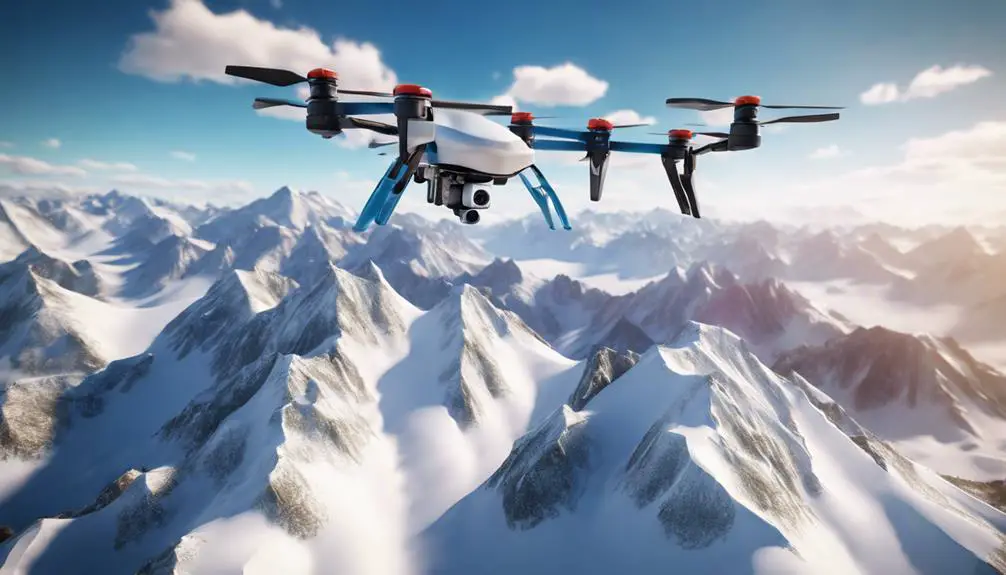Most drones can fly up to 400 feet due to regulations, but the actual height may vary. Several factors affect this, like weight, battery life, and weather conditions. While hobby drones are typically restricted to this altitude, some commercial models can soar higher. Innovations in battery and motor technology are pushing these limits further, potentially allowing for greater heights in the future. It's crucial to stay informed about local regulations to guarantee safe flying. If you're curious about what influences altitude capabilities and the types of drones involved, there's much more to explore!
Types of Drones
There are several types of drones, each designed for specific purposes and capabilities. If you're looking for freedom in exploration, recreational drones are perfect for capturing stunning aerial views. On the other hand, if you want to deliver packages or supplies, delivery drones are your go-to choice. For those who seek adventure, racing drones offer thrilling speed and agility. If you're into photography or surveying, camera drones provide unmatched aerial perspectives. Then there are agricultural drones, which help farmers monitor crops efficiently, promoting sustainable practices. Each type serves a unique purpose, allowing you to harness the power of flight in ways that align with your passions and goals, giving you the freedom to innovate and explore the sky.
Factors Affecting Altitude
Understanding the various factors that affect a drone's altitude is key to maximizing its performance, especially when considering the specific functions of different types of drones. Weather conditions play an essential role—high winds can push your drone off-course, while rain may impact its sensors. The drone's weight also matters; adding extra gear or payload can limit how high it can ascend. Battery life is another significant factor; drained batteries won't allow for ideal altitude. Finally, air density, which changes with temperature and altitude, influences lift. Knowing these elements can help you navigate your drone's limits effectively, giving you the freedom to explore the skies while ensuring a smooth flight experience. Embrace these factors and elevate your drone adventure!
Maximum Altitude Limits
Most drones have a maximum altitude limit that varies based on their design, purpose, and regulations. Understanding these limits is essential for your freedom to explore the skies. Here are three key factors affecting altitude limits:
- Regulatory Restrictions: Many countries impose legal altitude limits, often set around 400 feet for safety and airspace management.
- Drone Type: Commercial drones may have higher limits due to advanced technology, while hobby drones are typically capped lower.
- Battery Life and Weight: Heavier drones or those with lower battery capacity may struggle to reach higher altitudes due to power constraints.
Knowing these limits helps you navigate the skies responsibly while enjoying the exhilarating experience of flying your drone.
Technology Behind Flight Heights
Advancements in drone technology play a significant role in determining how high these devices can fly, enhancing both performance and safety. Manufacturers are constantly innovating, developing more powerful batteries, advanced sensors, and improved propulsion systems. These innovations allow drones to reach greater altitudes while maintaining stability and control. High-performance motors and lightweight materials also contribute to this freedom, enabling you to explore the skies without limitations.
Moreover, sophisticated navigation systems help you monitor altitude, ensuring your drone stays within safe operational parameters. With real-time data and enhanced communication systems, you can push boundaries, enjoying aerial adventures like never before. As technology evolves, your possibilities for flight heights expand, giving you the ultimate freedom to soar high above the world.
Local Regulations and Restrictions
Local regulations often dictate how high you can fly your drone, ensuring safety for both airspace users and the public. While you might yearn for the freedom to soar high, it's essential to stay informed about local rules that can impact your flying experience. Here are three key aspects to take into account:
- Altitude Limits: Many areas impose specific altitude ceilings, often around 400 feet, to prevent conflicts with manned aircraft.
- Restricted Zones: Certain locations, like airports and military bases, may have strict no-fly zones you need to respect.
- Permit Requirements: Some regions may require special permits for commercial or recreational flights beyond standard regulations.
Staying compliant not only safeguards your freedom but enhances the overall safety of the skies.
Safety Considerations for Drone Flight
Understanding local regulations is just the beginning; guaranteeing safety during drone flight is equally important for both you and those around you. Always maintain a clear line of sight with your drone to prevent collisions. Avoid flying near airports, crowds, or restricted areas, and be mindful of weather conditions that could impact your flight. Regularly check your drone's equipment to verify it's functioning properly, and keep an eye on battery levels to avoid sudden power loss. When you're flying, respect privacy by not invading others' personal space. Finally, consider using geo-fencing technology to help keep your drone within safe limits. Prioritizing safety not only protects your freedom to fly but also contributes to a more responsible drone community.
Future of Drone Altitude Capabilities
As drone technology continues to evolve, we're likely to see significant increases in altitude capabilities that could transform how we use these devices. The future looks promising, offering you greater freedom and opportunities in aerial exploration. Here are three potential advancements to watch for:
- Enhanced Battery Life: Improved power sources will allow drones to fly higher and longer, reaching previously inaccessible altitudes.
- Advanced Materials: Lightweight, durable materials will enable drones to withstand the challenges of high-altitude flight, enhancing their performance.
- Regulatory Changes: Evolving regulations may permit higher altitude operations, expanding your options for commercial and recreational use.
These advancements could redefine your experience with drones, empowering you to explore the skies like never before.

